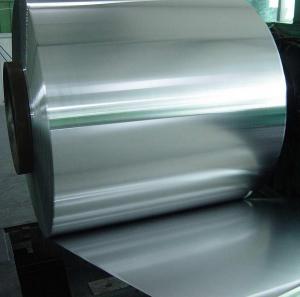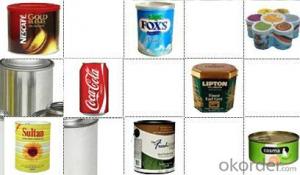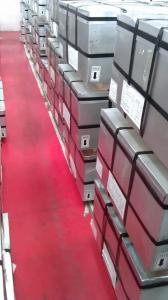Tinplate For Cans and Body Use with CA MR
- Loading Port:
- Tianjin
- Payment Terms:
- TT or LC
- Min Order Qty:
- 25 m.t.
- Supply Capability:
- 400000 m.t./month
OKorder Service Pledge
OKorder Financial Service
You Might Also Like
Prime Quality Tinplate Sheets Details:



Minumum Order Quantity: 25 MT Loading Port:China Main Port
Annual Capacity: 400,000MT Payment Terms:TT or LC
| | | | | | |
| | | | | |
Product Description:
Prime Quality Tinplate Sheets Usage and Applications
Prime Quality Tinplate Sheets Specifications
Standard : GB2520-2000 ,JIS G3303
Steel type : SPCC
Coating : 2.8/2.8
Surface: Bright, Stone ,
Thickness:0.18
Width :600MM~1000MM
Temper : T1~T5
Package: tinplate wrapped completely with an inner cover of plastic or waterproof papers with vorners protected with metal angels.
Applications
Chemicals and painting cans
Dry food cans, such as fancy cans, biscuit cans, milk power cans, tea cans
Liquid food cans, such as edible oil cans, beverage cans, Tomato paste cans
Sea food cans
Crown corks, easy open ends(EOE)
Electrical machinery parts
Bakeware and household kitchen parts
FAQ
CNBM Introduction
China National Building Materials Group Cooperation, as a leading state-owned enterprise with 3 billion USD and 40,000 staff in China, CNBM was established in 1984 under the administration of the state-owned Assets Supervision and Administration commission of the State Council. There are over 300 surbordinate factories and companies in our group; 2 public listed companies in Hong Kong, 4 Public listed companies in China mainland; 11 publicly listed companies in which CNBM has a substantial percentage of shares. The business scope of CNBM covers from Manufacturing and sales of building materials to scientific research and design, engineering, import and export trading.
On July 7th, 2011, Fortune Magazine established Fortune Global 500 ranking on its website, and CNBM Group was listed for the first time, with a ranking of 485.
CNBM International Corporation
CNBM International Corporation, as an important import and export platform of CNBM Group, enjoys competitive advantages in importing and exporting of building materials as well as complete sets of machinery and equipments, engineering, and project contracting.
CNBM Branch Offices
In order to promote the business connection, CNBM has established branches and offices in lots of foreign countries, such as USA, GERMANY, UAE, SAUDI ARABIA, IRAN, JORDAN, LIBIA,ETHIOPIA, INDONESA, INDIA,VIETNAM,RUSSIA,KAZAKHSTAN. It is very helpful for the communication and after- sale services.
Factory Introduction
CNBM as one of the largest suppliers in tinplate industry, offers clientss prime quality tinplate in both coil and sheets. With multi-plants and fully integraded production, the annual capacity of tinplate is 400,000MT.
To ensure the high quality if the tinplate, CNBM owns complete equipment series.
- Reversing cold rolling machines: 14 sets
- Continuous rolling machines: 2 sets
- BA furnaces: 50
- CA line: 1
- Tinplate production line: 2
- SA& DA reduced tinplate sheet: Available
CNBM also produce other steel products, such as cold-rolled steel, hot dip galvanized steel, color coated steel and tin free steel coils and sheets.
- Q: How does tinplate perform in terms of resistance to humidity?
- Tinplate performs exceptionally well in terms of resistance to humidity. The tin coating on the steel substrate provides a protective barrier that prevents moisture from reaching the metal, thus minimizing the risk of rust and corrosion. This makes tinplate an ideal packaging material for products that are sensitive to moisture, ensuring their integrity and longevity.
- Q: What are the main factors affecting tinplate coil surface finish?
- The main factors affecting tinplate coil surface finish are the quality of the tin coating, the cleanliness of the substrate, the surface roughness of the steel base, and the processing conditions during manufacturing.
- Q: And what are the main packing materials?
- Maguchi Tetsumi the tank is to sheet metal for tank type packaging materials by crimping, bonded resistance welding processing, by the tank body and the tank bottom and the tank cover is composed of three parts, a tank body packaging container joint, tank body and tank bottom and tank capping.
- Q: What are the main applications of tinplate in the furniture industry?
- Tinplate is widely used in the furniture industry for various applications such as decorative elements, hardware components, and protective coatings. It provides a durable and corrosion-resistant surface finish, making it ideal for metal furniture pieces. Tinplate is also commonly used in the production of metal furniture frames, as it offers excellent strength and stability. Additionally, tinplate can be utilized for intricate designs and embossing, enhancing the aesthetic appeal of furniture items.
- Q: How is tinplate tested for quality and durability?
- Tinplate is typically tested for quality and durability through various methods such as visual inspection, thickness measurement, coating evaluation, adhesion testing, corrosion resistance analysis, and mechanical property assessment. These tests ensure that the tinplate meets the required standards and can withstand the intended use, guaranteeing its quality and durability.
- Q: How does tinplate affect the overall product visibility?
- Tinplate can significantly enhance the overall product visibility due to its shiny and reflective surface. The reflective nature of tinplate allows for better light reflection, making the product more noticeable and eye-catching on store shelves. Additionally, tinplate can be easily printed upon, enabling vibrant and high-quality graphics that further attract consumer attention.
- Q: How does tinplate contribute to the durability of gardening tools?
- Tinplate contributes to the durability of gardening tools by providing a protective coating that prevents rust and corrosion. This helps to extend the lifespan of the tools, making them more resistant to wear and tear caused by exposure to moisture and harsh outdoor conditions.
- Q: What are the different tinplate surface finishes?
- Some common tinplate surface finishes include bright finish, stone finish, and matte finish.
- Q: How does tinplate contribute to the preservation of tobacco products?
- Tinplate contributes to the preservation of tobacco products by providing a durable and protective packaging material. It helps to prevent exposure to moisture, light, and air, which can negatively impact the quality and freshness of tobacco. Tinplate's ability to maintain a consistent environment inside the packaging helps to extend the shelf life of tobacco products and preserve their flavor and aroma.
- Q: How is tinplate stored and transported?
- Tinplate is typically stored and transported in rolls or sheets. It is commonly packaged in coils and secured with strapping or wrapping to prevent damage during transportation. These coils or sheets are then loaded onto trucks, ships, or trains for distribution to manufacturers and consumers. Additionally, proper handling and storage conditions are crucial to maintain the quality of tinplate, such as protecting it from moisture, extreme temperatures, and physical impact.
Send your message to us
Tinplate For Cans and Body Use with CA MR
- Loading Port:
- Tianjin
- Payment Terms:
- TT or LC
- Min Order Qty:
- 25 m.t.
- Supply Capability:
- 400000 m.t./month
OKorder Service Pledge
OKorder Financial Service
Similar products
Hot products
Hot Searches
Related keywords




























